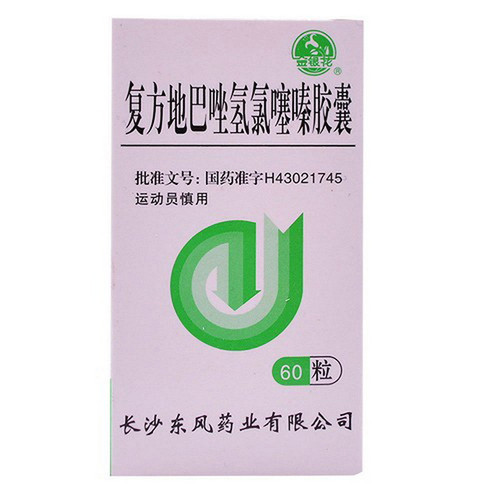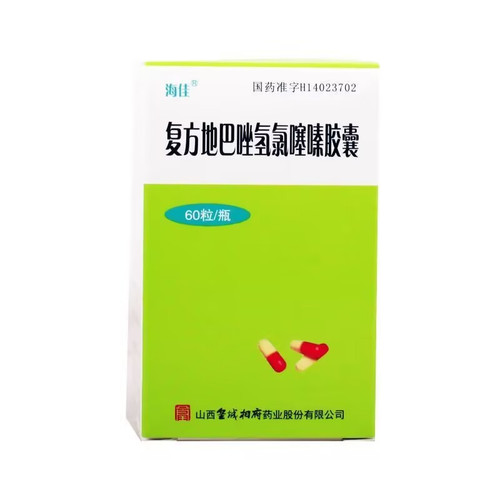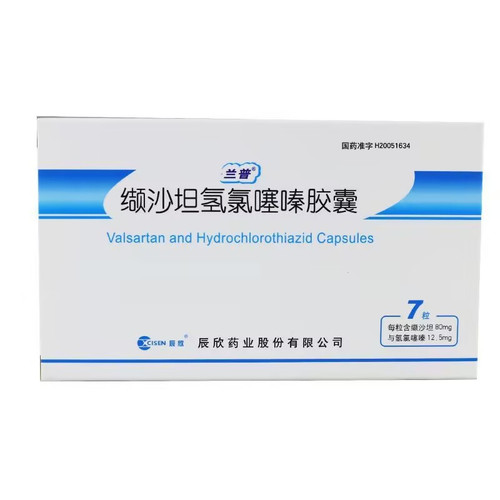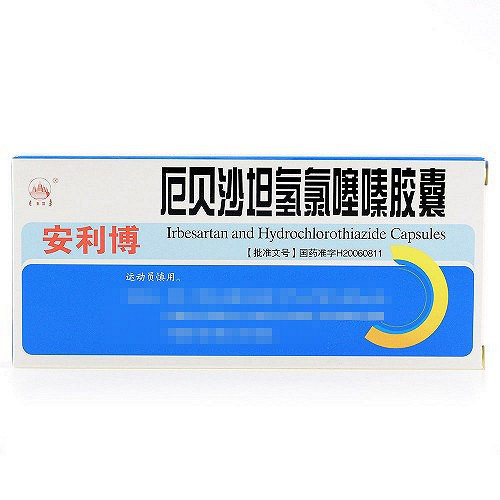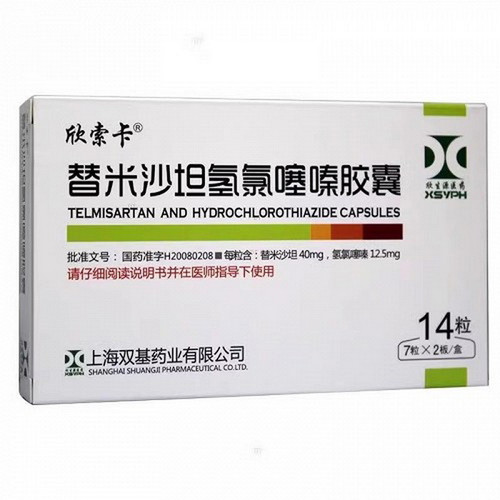Product Overview
[Drug Name]
Generic Name: Compound Dibazo Hydrochlorothiazide Capsules
Trade Name: Kangshou Compound Dibazo Hydrochlorothiazide Capsules (60 Capsules)
Pinyin Code: KangShou FuFangDiBaZuoQingLvZuoZuoJiaoNang 6OLi
[Main Ingredients]
Dibazo, promethazine hydrochloride, chloroquine phosphate, guanidine sulfate, vitamin B6, potassium chloride, reserpine, chlordiazepoxide, hydrochlorothiazide, calcium lactate, vitamin B1, magnesium trisilicate.
[Properties]
This product consists of white or off-white granules or powder.
[Indications/Main Functions]
For hypertension.
[Specifications]
60 capsules
[Dosage and Administration]
Oral. The usual dosage is one capsule three times daily, or as directed by a physician.
[Adverse Reactions]
1. Long-term use of this product may cause diarrhea, dizziness, fatigue, weakness, dry mouth, drowsiness, loss of appetite, nausea, vomiting, and nasal congestion. Symptoms may also include tinnitus, rash, headache, dizziness, depression, and bradycardia. If symptoms persist, caution is advised. 2. Be aware of orthostatic hypotension, electrolyte imbalance, hypokalemia, hyponatremia, and hypochloremia. 3. This product contains reserpine, which may cause parkinsonism, depression, and worsening symptoms of peptic ulcers. 4. The chloramine in this product may cause withdrawal symptoms, including insomnia, abnormal irritability, and nervousness after discontinuation. The elderly, frail, and patients with liver disease are more sensitive to its central nervous system inhibitory effects.
[Contraindications]
1. Contraindicated for pregnant and lactating women. 2. Contraindicated for infants and young children. 3. Contraindicated for patients with severe hepatic and renal insufficiency. 4. Contraindicated for patients with severe heart failure. 5. Contraindicated for patients with allergies to its ingredients.
[Drug Interactions]
1. Guanidine sulfate: (1) When used with ethanol, barbiturates, and sleeping pills, it may aggravate orthostatic hypotension. (2) When used with amphetamine or other appetite suppressants, phenothiazines, tricyclic antidepressants, etc., the orthostatic hypotensive effect is weakened. (3) When used with hypoglycemic drugs, it may enhance the hypoglycemic effect and the dose must be adjusted. (4) When used with nonsteroidal anti-inflammatory analgesics, the hypotensive effect of this product is weakened because the former may inhibit adrenal prostaglandins and cause water and sodium retention. (5) When used with other antihypertensive drugs such as reserpine, α or β blockers, it may increase orthostatic hypotension. It is generally not recommended to use it with minoxidil. (6) When used with sympathomimetics, the hypotensive effect of this product is weakened and the pressor effect of sympathomimetics is enhanced. The use of metaraminol with this product may lead to hypertensive crisis. 2. Promethazine hydrochloride: (1) When ethanol or other central nervous system depressants, especially anesthetics, barbiturates, monoamine oxidase inhibitors or tricyclic antidepressants are used together with this product, the effects of promethazine or (and) these drugs may be enhanced, and the dosage should be adjusted separately. (2) When anticholinergic drugs, especially atropine drugs, are used together with promethazine, the antimuscarinic effect of the latter is enhanced. (3) When antihypertensive drugs such as brombenzylamine, debrisoquine or guanethidine are used together with promethazine, the antihypertensive effect of the former is enhanced. When epinephrine is used together with promethazine, the α effect of epinephrine can be blocked, and the β effect can be dominant. (4) When ototoxic drugs such as cisplatin, paromomycin and other aminoglycoside antibiotics, salicylic acid preparations and vancomycin are used together with promethazine, their ototoxic symptoms can be masked. 3. Reserpine: (1) When used together with ethanol or (1) Combination with CNS depressants can aggravate the central nervous system inhibitory effect; (2) Combination with other antihypertensive drugs or diuretics can enhance the antihypertensive effect and require dose adjustment. Combination with β-blockers can enhance the latter's effect; (3) Combination with digitalis or quinidine can cause arrhythmias at high doses; (4) Combination with levodopa can cause dopamine depletion, leading to Parkinson's disease; (5) Combination with indirect adrenergic drugs such as ephedrine and amphetamine can cause catecholamine storage depletion. ; Inhibits the effects of adrenergic drugs; (6) When used in combination with direct adrenergic drugs such as epinephrine, isoproterenol, norepinephrine, metaraminol, phenylephrine, etc., the effects can be prolonged; (7) When used in combination with tricyclic antidepressants, the effects of reserpine and antidepressants are weakened; (8) Barbiturates can enhance the central sedative effect of reserpine. 4. Hydrochlorothiazide: (1) Adrenocortical hormone, adrenocorticotropic hormone, estrogen, amphotericin B ( (1) Intravenous administration) can reduce the diuretic effect of this drug and increase the chance of electrolyte imbalance, especially hypokalemia. (2) Non-steroidal anti-inflammatory analgesics, especially indomethacin, can reduce the diuretic effect of this drug, which is related to the former's inhibition of prostaglandin synthesis. (3) When used in combination with sympathomimetic amines, the diuretic effect is weakened. (4) Cholestyramine (cholestyramine) can reduce the gastrointestinal absorption of this drug, so this drug should be taken 1 hour before or 4 hours after oral administration of cholestyramine. (5) When used with multiple When used in combination with dapamine, the diuretic effect is enhanced. (6) When used in combination with antihypertensive drugs, the diuretic and antihypertensive effects are enhanced. (7) When used in combination with antigout drugs, the latter should adjust the dosage. (8) It weakens the effect of anticoagulants, mainly because the plasma volume of the body decreases after diuresis, the level of coagulation factors in the blood increases, and diuresis improves the blood supply to the liver and increases the synthesis of coagulation factors. (9) It reduces the effect of hypoglycemic drugs. (10) When digitalis drugs, amiodarone, etc. are used in combination with this drug, caution should be taken to prevent hypoglycemic effects. Side effects caused by potassiumemia. (11) When used in combination with lithium preparations, this drug can reduce the kidney's clearance of lithium and increase lithium nephrotoxicity. (12) When used in combination with this drug, the former is inhibited from converting to formaldehyde, and the efficacy is reduced. (13) It enhances the effect of non-depolarizing muscle relaxants, which is related to the decrease in blood potassium. (14) When used in combination with sodium bicarbonate, the chance of hypochloremic alkalosis increases. 5. Chlornithine: (1) When this product is used in combination with addictive and other potentially addictive drugs, the risk of addiction is increased. (2) When used in combination with alcohol and general anesthetics, clonidine, analgesics, monoamine oxidase inhibitors and tricyclic antidepressants, the effects of the drug may be enhanced. (3) When used in combination with antacids, the absorption of the drug may be delayed. (4) When used in combination with antihypertensive drugs or diuretics, the antihypertensive effect of the drug may be enhanced. (5) When used in combination with calcium channel antagonists, the hypotension may be aggravated. (6) When used in combination with cimetidine, the liver metabolism of the drug may be inhibited, thereby clearing Elimination is slowed and blood drug concentration increases. (7) When this product is used in combination with purchasinolol, the type and/or frequency of epileptic seizures may change, and the dosage should be adjusted promptly. (8) When this product is used in combination with carbamazepine, the induction of liver microsomal enzymes may reduce the blood drug concentration of both drugs and shorten the elimination half-life. (9) When this product is used in combination with levodopa, the efficacy of the latter may be reduced. (10) When this product is used in combination with the antifungal drugs ketoconazole and itraconazole, the efficacy of this product may be enhanced while increasing its toxicity.
[Precautions]
1. Interference with Diagnosis: This combination preparation contains promethazine, which may indicate increased glucose tolerance in a glucose tolerance test. It may also interfere with urine pregnancy immunoassays, resulting in false-positive or false-negative results. 2. Use with caution in the following situations: ① Those with a history of asthma may experience a depletion of catecholamines, leading to the onset or worsening of symptoms; ② Those with cerebral vascular insufficiency may experience aggravated cerebral ischemia due to low blood pressure; ③ Heart failure not caused by hypertension may be aggravated by fluid retention; ④ Those with coronary artery insufficiency and those with a recent myocardial infarction may experience aggravated myocardial ischemia due to decreased blood pressure; in patients with diabetes, this drug enhances the effects of hypoglycemic drugs; in patients with hepatic insufficiency, this drug's metabolism is slowed, leading to accumulation in the body; in patients with peptic ulcers, this drug may aggravate their condition due to the relative increase in parasympathetic tone; in patients with pheochromocytoma, this drug may aggravate their condition due to the initial increased release of catecholamines; in patients with renal insufficiency, this drug reduces glomerular filtration rate and renal blood flow, and the accumulation of this drug may lead to hypotension and temporary urinary retention; this drug may aggravate bradycardia. 3. This combination preparation contains promethazine hydrochloride: ① Pay special attention to the possibility of intestinal obstruction, drug overdose, or poisoning, as symptoms and signs may be masked by the antiemetic effect of promethazine. ② Cross-sensitivity. Patients known to be highly allergic to phenothiazines may also be allergic to this product. Please read the instructions carefully and use as directed by your doctor.
[Pediatric Use]
Antihistamines pose a significant risk to infants, especially newborns and premature infants, and are therefore contraindicated in infants and young children.
[Elderly Use]
The elderly are sensitive to antihypertensive effects, and renal function may decline with aging, so the dosage should be reduced.
[Overdose]
Unknown.
[Pharmacology and Toxicology]
This product is a combination antihypertensive drug. Dibazole has a direct relaxant effect on vascular smooth muscle, reducing external resistance and lowering blood pressure. It also has an antispasmodic effect on gastrointestinal smooth muscle. Reserpine achieves its antihypertensive, heart rate-lowering, and central nervous system-depressing effects by depleting norepinephrine from peripheral sympathetic nerve endings, thereby depleting catecholamine and serotonin stores in the heart, brain, and other tissues. Its antihypertensive effects are primarily achieved by reducing cardiac output, lowering peripheral resistance, and partially inhibiting cardiovascular reflexes. The heart rate-lowering effect is not significant in patients with a normal heart rate, but is significant in those with sinus tachycardia. Reserpine acts on the hypothalamus to produce a sedative effect without causing drowsiness or anesthetic effects. It does not alter the electroencephalogram (EEG) during sleep and can relieve anxiety, tension, and headaches in hypertensive patients. In the early stages of treatment, hydrochlorothiazide, through diuresis and sodium excretion, reduces plasma and extracellular fluid volume, blood volume, and cardiac output, thereby lowering blood pressure. With prolonged administration, blood volume and cardiac output may return to their original levels, but total peripheral vascular resistance decreases, and blood pressure may still be lowered. Guanidine sulfate selectively acts on sympathetic postganglionic adrenergic nerve endings, slowly replacing stored norepinephrine with the drug and releasing it. This depletes the necessary norepinephrine in nerve endings and tissues. It also blocks the normal release of norepinephrine in response to nerve stimulation, weakening vasoconstriction. This weakens sympathetic nerve responses, especially during changes in body position, and reduces the necessary excitation, thereby lowering blood pressure. The mechanism by which promethazine hydrochloride inhibits the central nervous system has not been fully elucidated, but it may indirectly reduce the excitability of the brainstem reticular activating system. It also has anti-motion sickness effects. Chlornithine's mechanism of action is related to its selective action on the limbic system, where it binds to central benzodiazepine receptors, promoting the release of gamma-aminobutyric acid and enhancing synaptic transmission. It also has central muscle relaxant and anticonvulsant effects. Low doses have anxiolytic effects, while increasing doses can produce sedation, hypnosis, and memory impairment. Potassium chloride and calcium lactate in the formula are used to supplement potassium and calcium.
Magnesium trisilicate has a mild laxative effect. Nonclinical acute toxicity test: LD50 = 10.525 g/kg. (Feiller correction) 95% confidence limit = 9.5731-11.592 g/kg.



